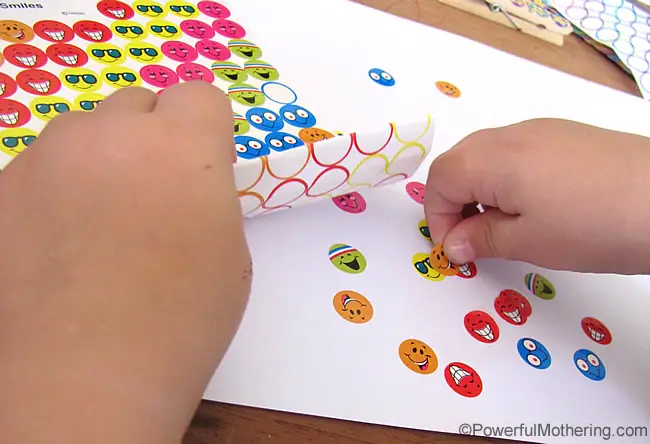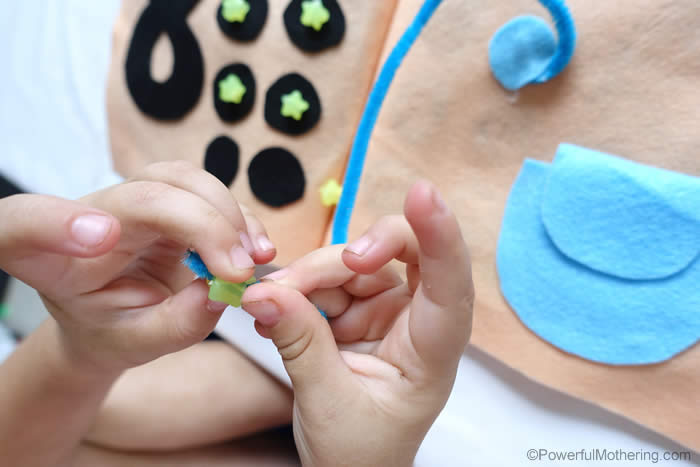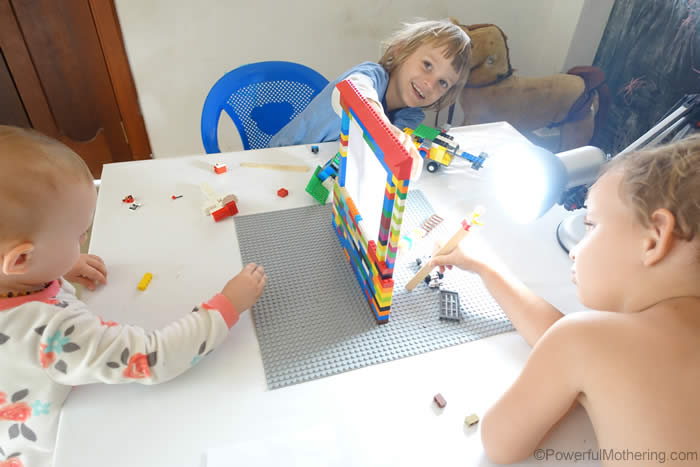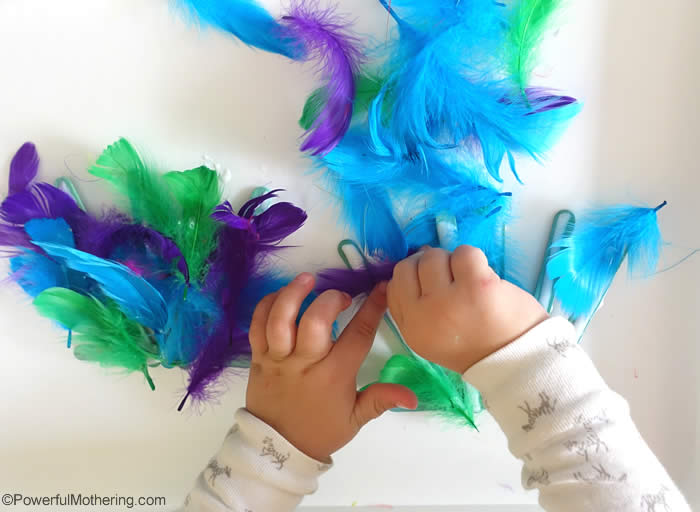Browse all Fine Motor activities
A lot of parents worry about preschool and kindergarten readiness and how to develop those prewriting skills in toddlers and preschoolers. The best way to give your child a head start in this department is through development of fine motor skills.
Working on fine motor skills helps your little one have more control over the small muscles in their hands and fingers.
What are fine motor skills?
Really, it’s anything that involves control of the muscles in your child’s hand, fingers, and thumb.
Ways to Develop Fine Motor Skills in Children
Children need opportunities to learn and master their fine motor skills. Thankfully, there’s a lot you can do with household objects that doesn’t cost a lot or require much prep.
In the early stages, have your toddler practice their pincer grasp by scattering toddler-safe objects. Cheerios or other snacks spread out on the high chair tray work perfectly. Just using the pincer grasp to pick up the treats helps to improve coordination.
For preschoolers, take full advantage of the “I can do it myself!” phase. Even if it’s frustrating, let your child dress and undress themselves. Teach them properly cutlery use and encourage self-feeding. Colouring pages or tracing activities are great at this age to develop pre-writing skills. Of course, continue to offer fine motor manipulatives like dough or small objects, but challenge preschoolers to do more complicated tasks with them.
A Simple List of Fine Motor Activities
- Picking up small objects with the thumb and forefinger
- Cutting with scissors
- Writing and pencil control
- Buttoning clothing and working a zipper
- Using play dough in various ways
- Playing with building toys like LEGO
Children continue to work on their fine motor skills through their early years to master activities like these.
Toddlers are in the early stages of fine motor development. Your 1-3 year old will learn how to scribble and eventually draw lines, play with Play Dough, build small block towers, snip with child safe scissors, feed themselves, and turn the pages of a book.
By age 5, you preschooler should have more advanced fine motor skills. Some of these will include learning to hold a pencil or crayon properly, dressing themselves independently, cutting on a line, and writing their name.
-
 99 & 100 Fine Motor Ideas Bundle$16.99
99 & 100 Fine Motor Ideas Bundle$16.99 -
 100 Fine Motor Ideas$9.99
100 Fine Motor Ideas$9.99 -
 99 Fine Motor Ideas$9.99
99 Fine Motor Ideas$9.99
How to Improve Fine Motor Skills in Toddlers and Preschoolers
You might not even realize it, but your child’s already been working on their fine motor skills. The same muscles that babies use to grip small pieces of food while self feeding (also called the pincer grasp) are used to hold a pencil as they get older. Although these skills do develop naturally, it’s important that parents and caregivers give plenty of opportunities for it to happen.
One of the best ways to develop fine motor skills in children is through fun activities. You can start as soon as your baby begins to develop their pincer grasp at around 9 months old. If you already have a toddler or preschooler, though, it’s never too late to start practicing!
Fine Motor Ideas for Toddlers & Preschoolers

Playdough Fine Motor Skills
Toddlers can start flexing their fine motor abilities by manipulating dough. Playdough is popular, safe, and fun either store bought or homemade. You can also get your little one involved in the kitchen by rolling and cutting out cookies together, kneading dough, or stirring the mixture.

- Homemade Playdough Recipe plus Tools for Play – This is our favorite homemade playdough recipe and some of the tools we keep as staples.
- How Play Dough Can be One of the Best Teaching Tools – Another article full of ideas to use playdough as a feature in teaching younger kids.
- Amazing 2 Ingredient Homemade Edible Play Dough – have a kid who wants to put things in their mouth? Try this dough instead.
- Chocolate Oat Cookies turned Edible Play Dough
- Fine Motor Skills with Pasta and Play Dough
- Exploring Play Dough with Different Effects
- Caterpillar to Butterfly with Play Dough – This is an example of using a childs interest to create activities
- Learning Emotions With Face Playdough Mats
- Printable Playdough Number Mats
- Rainbow Playdough Counting and Fine Motor Activity
- Make a Rainbow with Playdough Printable
- Playdough Scene Creation
- Expand Playdough play with other Toys
- Loose Parts & Playdough – Loose parts allow for open expression and creation.
- Dinosaur Weekend with Playdough and More – Use plastic animals with playdough!
Cutting Activities for Fine Motor Skills (Scissors)

- Cutting & Threading Practice with Straws
- Cutting Practice and Games with Gift Wrap – This is a great up-cycling idea to use with gift wrap from all occasions. Later use those bits with glue and paper!
- Plastic Bag Flowers – Cutting Skills in Practice
- Dot & Cut (Fine Motor & Scissor Skills) – This one is an absolute fav with the kids. I guess anything with the dot dabbers involved is!
Sticker Activities
Stickers provide a great opportunity for fine motor skills, pincer exercises and some logical thought patterns on how to get those tricky stickers off the sheets they come on in the first place. Do see our pro tip to make this easier for the kids!

- Using Stickers for Fine Motor Skills – This post has a ton of tips to make the most out of your stickers.
- Stickers For Toddlers
- Color Recognition with Stickers
- Free Play Easter Activity Idea with Stickers
- Connect the Stickers
- Learn to Count! (1-10 Printable) – This is a multi-purpose printable. We have used it with buttons, playdough, pom poms and a host of other manipulatives!
Pom Pom Fine Motor Activity

- Feeding the Monster
- Posting Pom Poms For Toddlers
- Pom Poms in a Box For Toddlers
- Fine Motor Practice with Pom Poms and Pinecones
- Pom Pom Post and Blow Activity
- Sorting Pom Poms
- Tiny Pom Pom Fine Motor Skills
- Magnetic Pom Poms for Toddlers & Preschoolers – These are great for vertical surface activities
- Feather and Pom Pom Trees Fine Motor Skills – pictured above
- Dinosaur 1-20 Frames for Preschool – Use pom poms in this activity that features math.
Pipe Cleaner Activities
- Really Quick Fine Motor Play
- Safe Bead Exploration for Toddlers
- Beaded Flowers for Fine Motor Skills
- No Sew Counting and Numbers Quiet Book – Part 2
- Fine Motor Pipe Cleaner Tree – Christmas Busy Bags
- Quick Candy Cane Christmas Ornament
- Easy Christmas Ornaments for Kids: Pipe Cleaner + Beads
Threading Skills

- How to make Foam Lacing Shapes
- Cutting & Threading Practice with Straws
- Sensory Search and Find Name Threading
- The Very Hungry Pasta Bead Caterpillar
- Threading Pipe Cleaners – This happens to be christmas themed but can totally be done anytime of the year.
- No Sew Counting and Numbers Quiet Book – Part 4
LEGO Fine Motor Ideas

- Counting with LEGO
- Lego Indian Corn Craft for Kids
- My Emotions with LEGO
- LEGO Christmas Tree Fine Motor Activity
- LEGO Stamping Activity
- LEGO Puppet Theatre
- Simple LEGO Game with Dice & Counting for Kids
- Skip Counting with LEGO
- Build a LEGO Catapult
Fine Motor Busy Bags

- Counting Caterpillar Busy Bag (Printable Numbers 1-10)
- Shapes, Counting and Colors Busy Bag (with Printable)
- Everyday Fine Motor Materials – P is for Paperclip (Busy Bag)
- Watermelon 1-20 Counting Busy Bag
- Search and Find Bug Busy Bag
- DIY Rainbow Clip Busy Bag – pictured above
- Apple Seed Counting Busy Bag
- Feed Rudolf the Reindeer – Christmas Busy Bags
- Gingerbread Man Shape Matching Busy Bag
- Felt Color Sorting Busy Bag
- Super Fine Motor Activity for Busy Bags
- Busy Bags for Fine Motor Activities
- 10 Ready to Use Items for Busy Bags
Tracing/Pre-writing Activities
It’s easy as a parent or caregiver to compare children, and writing ability is a common comparison. Every child develops this at their own pace, but there are some things that you can do to help teach or improve a child’s writing.
Fine motor activities for toddlers and preschoolers develop pre-writing skills. If you have a child who’s struggling with pencil grip or writing, you need to step back and work on basic skills first. Kids walk before they run, and they draw straight lines and learn proper pencil grip before they write their name!

- Pencil Control for Early Learners
- Line Tracing with Loose Parts
- Drawing Tray For Toddlers
- Free Printable Shape Tracing Strips
- Free Printable Number Strips For Handwriting & Number Recognition
- Community Helper Prewriting Practice
- Colored Salt Writing Tray for Reluctant Writers
- 25+ Writing Activities Even Reluctant Writers Will Love
- Name Tracing Printable – pictured above
Is Coloring a Fine Motor Skill?
Short answer, YES! Coloring increases the endurance of the hand. You will notice those that don’t color often complain of tired hands. Try offering them different shapes of crayons and coloring pages that cater to their interests to increase the change of them building up these muscles.
Tools for Toddlers & Preschoolers
Uses for the Fine Motor Tools Set
You can read more about fine motor delays here.
-
 Custom Name Tracing Worksheet BundleOriginal price was: $5.00.$3.75Current price is: $3.75.
Custom Name Tracing Worksheet BundleOriginal price was: $5.00.$3.75Current price is: $3.75. -
 Rice PlayOriginal price was: $4.99.$2.99Current price is: $2.99.
Rice PlayOriginal price was: $4.99.$2.99Current price is: $2.99.

















